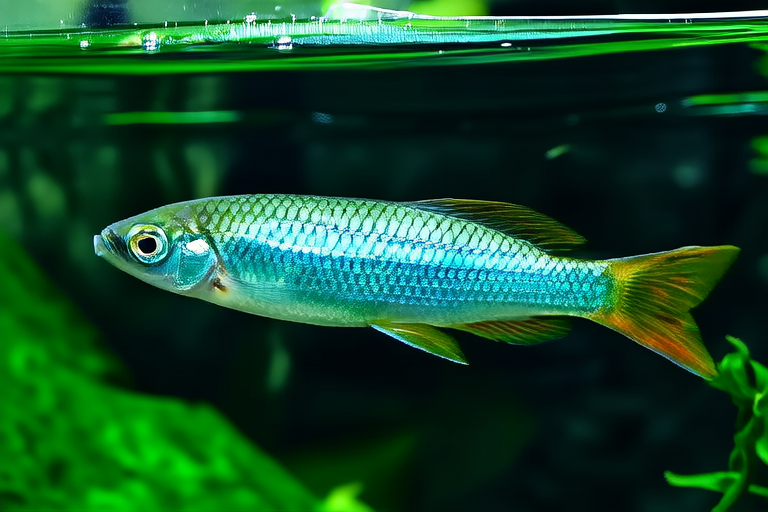A Royal Encounter: Everything You Need to Know About Rajah Cichlids
Welcome to the world of Rajah cichlids, a species that will captivate your interest with its regal appearance and intriguing behavior. These fish, scientifically known as Vicaria synspila, belong to the family Cichlidae and are native to the Amazon Basin. With their striking colors and complex social dynamics, Rajah cichlids offer an enriching experience for both novice and seasoned aquarists. This article aims to provide you with all the necessary information about these majestic creatures, from their physical attributes to their care requirements.
Physical Characteristics
Rajah cichlids are characterized by their vibrant hues and distinct patterns, which make them stand out in any aquarium. Adult males typically reach lengths of around 8 inches, while females tend to be slightly smaller at approximately 6 inches. Their bodies are adorned with electric blue spots that contrast beautifully against their golden-brown scales. Additionally, they possess elongated fins that add to their graceful appearance. One of the most notable features of Rajah cichlids is their pronounced nuchal hump, which develops more prominently in males during breeding season.
These fish also exhibit sexual dimorphism, meaning there are visible differences between male and female specimens beyond size. Males often display brighter colors and larger nuchal humps compared to females. However, distinguishing between genders can sometimes be challenging without observing behavioral cues or examining secondary sexual characteristics closely.

Native Habitats
Native to the Amazon Basin, Rajah cichlids inhabit slow-moving rivers and tributaries where water conditions are relatively stable year-round. They prefer areas rich in vegetation and hiding spots, such as submerged branches and rocks. In nature, these environments provide ample cover from predators and facilitate territorial disputes among conspecifics.
The ideal water parameters for maintaining Rajah cichlids in captivity closely mimic those found in their natural habitat. Aim for a pH level between 6.0 and 7.5, temperatures ranging from 75°F to 82°F (24°C to 28°C), and moderate hardness levels. Regular water changes and proper filtration systems help maintain optimal conditions within your aquarium.
Dietary Needs
As omnivorous feeders, Rajah cichlids require a balanced diet consisting of both plant matter and protein sources. In the wild, they consume algae, small insects, crustaceans, and detritus. When keeping Rajah cichlids in captivity, it’s essential to replicate this varied diet as closely as possible.
In terms of commercial foods, high-quality pellets formulated for cichlids work well as a staple food source. Supplementing their diet with occasional treats like frozen bloodworms, brine shrimp, or spirulina flakes ensures nutritional completeness. It’s crucial not to overfeed these fish; offering small portions twice daily suffices.
Breeding Behaviors
Rajah cichlids are monogamous breeders who form long-lasting pair bonds. During spawning, pairs prepare a flat surface or cave-like structure where eggs will be laid. The female usually deposits between 200 and 300 adhesive eggs, which she then guards fiercely alongside her partner. Both parents take turns fanning the eggs with their fins to ensure adequate oxygenation.
Once hatched, fry remain attached to the substrate for several days before becoming free-swimming. At this point, parents continue protecting their offspring until they reach juvenile stages. Providing suitable breeding sites and maintaining stable environmental conditions encourages successful reproduction.
Common Health Issues
Like many tropical fish species, Rajah cichlids are susceptible to various health problems if kept under suboptimal conditions. Some common ailments include ich, fin rot, and parasitic infections. Early detection and prompt treatment are key to managing these issues effectively.
To prevent illness, focus on providing clean water through regular maintenance routines, including partial water changes and thorough filter cleaning. Quarantining new additions before introducing them into your main tank helps safeguard existing populations from potential pathogens.
Tank Setup Requirements
Creating a suitable environment for Rajah cichlids involves careful consideration of space allocation, decor placement, and equipment selection. A minimum tank size of 55 gallons is recommended for a single pair, but larger setups accommodate additional specimens comfortably.
Substrate options range from fine sand to medium-sized gravel, depending on individual preferences and desired aesthetics. Incorporate plenty of live plants, driftwood pieces, and rock formations to mimic natural habitats and offer hiding places. Adequate lighting promotes healthy plant growth and enhances overall visual appeal.
Tips for Owners
For Beginners:
- Start with a basic understanding of cichlid biology and behavior before setting up your first tank.
- Select compatible tankmates carefully; avoid overly aggressive species that might intimidate Rajah cichlids.
- Invest in reliable testing kits to monitor water quality regularly.
For Experienced Aquarists:
- Experiment with different breeding techniques to increase reproductive success rates.
- Consider incorporating advanced filtration methods like wet/dry filters for superior water clarity.
- Participate in local fishkeeping communities to share knowledge and experiences with fellow enthusiasts.
In conclusion, Rajah cichlids present a rewarding challenge for aquarists willing to invest time and effort into creating optimal living conditions. By understanding their unique needs and adopting best practices, you can enjoy watching these magnificent fish thrive in your home aquarium.
